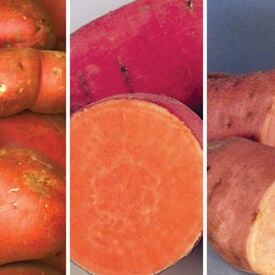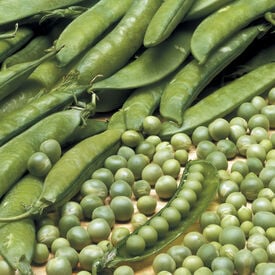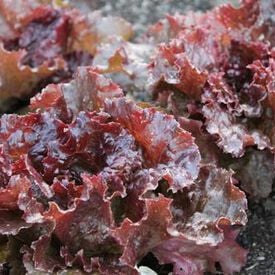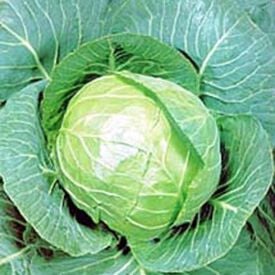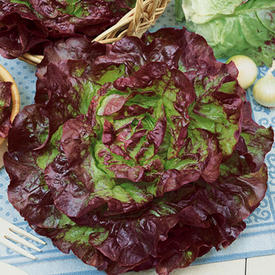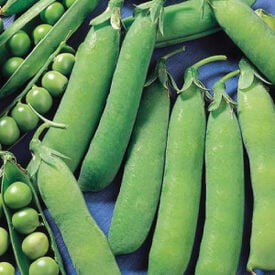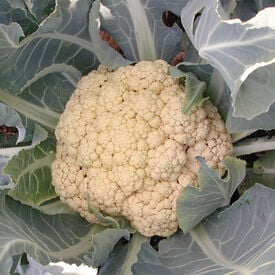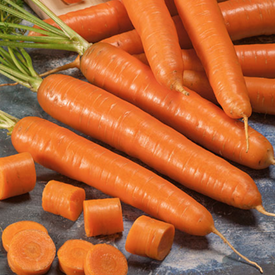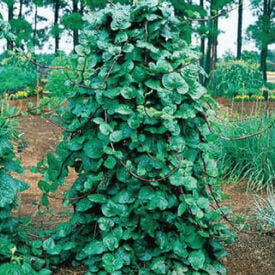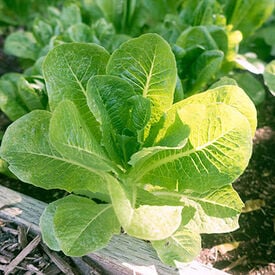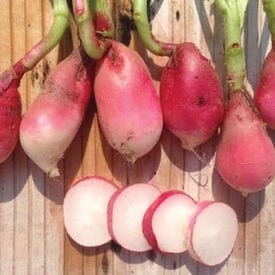Enjoy a mouth watering blend of the Sweet Potato Mix! This mix contains all 3 of the sweet, delicious sweet potato varieties that we carry, the Georgia Jets, Beauregard and Centennial. Not sure which variety to buy? Try all 3!
The Lincoln Pea is an extra tender variety with a sweet flavor and high yields. This pea variety was introduced just after World War II during the peace time. Lincoln quickly became a popular home garden variety due to its versatility, as it can be eaten fresh, froze or canned. Its pods can reach 4-5" in length and are full of 6-9 sweet, tender peas. Lincoln does well in heat and should have a small pea fence or some sort of support or its vines.
The Red Sails Lettuce is a full rosette type that produces radiant bronze-red, ruffled and deeply lobed leaves that have a mild bitter-free flavor that pairs very well in salads. This slow-bolting lettuce is ready to cut early and holds its quality very well. Red Sails has six times the vitamin A and three times the vitamin C as other supermarket lettuces. This variety thrives in cool weather, but can also grow well in the spring, summer or fall.
The Golden Acre is a tasty cabbage that arrives early and is suited for close spacing. This early round head cabbage is easily grown and versatile in use. Heads are about 6 to 7 inches in diameter on compact plants about a foot high. Its firm, medium green head is excellent cooked or raw in stews and salads.
Carmona Red is a favorite among many market growers! This lettuce variety produces big, bright red heads with lime green hearts. The Carmona Red has a nice silky texture and is very disease resistance.
Wando pea seeds are a popular heirloom variety known for their cold tolerance and early harvest. They produce vibrant green, sweet-tasting peas that are perfect for fresh eating, freezing, or cooking. The seeds grow into plants that are typically 18-24 inches tall, making them ideal for small gardens or containers. Wando peas are well-suited for cooler climates, as they can withstand light frosts and thrive in temperatures between 55°F and 75°F. With a quick maturation time of about 60-70 days, they are a great choice for gardeners looking to enjoy peas early in the growing season. Their resilience and ease of growth make them a favorite among both beginner and experienced gardeners.
Cylindra beets, also known as "Formanova" or "Butter Slicer," are a unique variety of beetroot known for their elongated, cylindrical shape. These beets have a fascinating history, originally hailing from Europe, particularly Denmark, where they were developed in the early 20th century. Their distinctive shape was cultivated to make them easier to slice and can, a practical innovation that has made them popular among home gardeners and commercial growers alike. In terms of taste, cylindra beets are mild and sweet, with a slightly earthy flavor. They are known for their tender, non-fibrous texture, making them excellent candidates for pickling, roasting, or slicing thinly for salads. Their deep red-purple skin contrasts beautifully with the vibrant, dark red flesh inside, adding an attractive element to culinary dishes. Cylindra beets typically grow to be 6-8 inches in length and 2 inches in diameter. They are ready for harvest in approximately 55-65 days from planting, making them a relatively quick-growing beet variety. They thrive in well-drained, loamy soil with full sun exposure. When it comes to disease resistance, cylindra beets tend to be more resistant to common beet diseases like leaf spot and powdery mildew than some other beet varieties. Proper spacing is crucial, with about 2-3 inches between each plant and rows spaced 12-18 inches apart. With the right care and growing conditions, cylindra beets can yield a bountiful crop of these delicious and uniquely-shaped vegetables, making them a favorite among gardeners and chefs.
The Snow Crown cauliflower is a delicious, mild and sweet hybrid. This cauliflower's head will get to 7-8 inches across and 1-2 pounds. The Snow Crown is extra early and adaptable and can be harvested in summer or fall. Be careful not to under-fertilize or water, stress can cause a purplish discoloration on the undersides of the head.
The Bambino carrot is a super sweet baby gourmet carrot. The color develops quickly and can pull early. This carrot produces 4 in. cylindrical blunt roots, very small core, smooth skin, a deep orange color and small dwarf tops. The Bambino was developed for canning & pickling whole and must be harvested early.
The Malabar Red Stem Spinach is a beautiful climbing spinach that looks and taste great! This vigorous climbing vine needs to be trellised and grows into fall. This spinach variety has a taste that resembles a mild Swiss chard. Use Malabar Red Stem's leaves and young stems sparingly in salads or stir-fries.
The Little Caesar Lettuce is a very attractive tall romaine type with crisp, bright green outer leaves and golden-blanched inner leaves. This lettuce has a sweet, crunchy flavor that is delicious on any sandwich or salad. This variety is easy to grow and is perfect for smaller gardens. Little Caesar is best picked right before eating.
The French Breakfast Radish has a delicate flavor and is an excellent variety for home gardens. This radish variety is an attractive uniquely shaped radish with elongated roots and red tops with white tips. The French Breakfast has an excellent flavor and texture, that is perfect for dips or as a garnish.
